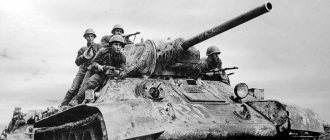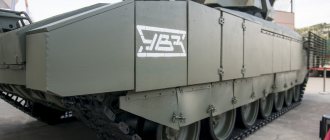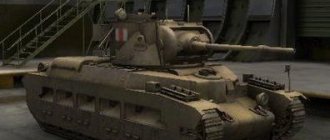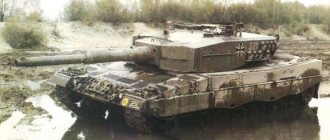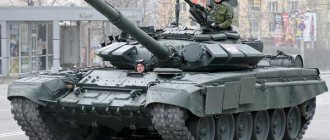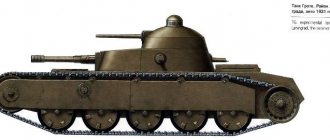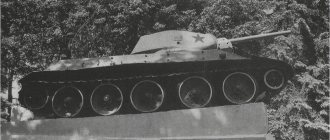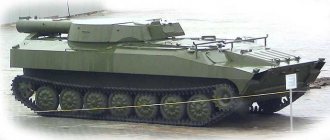The World of Tanks game features quite a few historical vehicles with different characteristics. Perhaps one of the most extraordinary tanks is the T-34-3. This is a preferential premium vehicle of the 8th level, the Chinese branch of tanks. Initially, the tank was positioned as an alternative to the legendary TYPE-59, however, this is not the case. The key feature of the T 34-3 is the installation of weapons on a medium tank that are more suitable for a heavy tank. This approach requires not only getting used to, but also certain game tactics, which we will discuss in a detailed review below. The cost of the T-34-3 is 11,000 gold when purchased through the game clients.
Elite equipment
| Price | 11,000 gold |
| Strength | 1300 HP |
| Weight/max. | 35.5/38.0 t. |
| Power | 520 hp |
| Speed | 50/20 km/h. |
| Agility | 46 °/s |
| Frame | 100/80/45 mm. |
| Tower | 200/130/60 mm. |
| Ammunition | 40 pcs. |
| Damage | 390/390/465 HP |
| Breakthrough | 186/250/61 mm. |
| Reload | 14.4 sec. |
| GN speed | 46 °/s |
| Angles VN | -7…+15° |
| Review | 380 m. |
| Connection | 600 m. |
Tactics
In many ways, the tactics are very similar to those on type. But there is a small nuance. If on the older brother we can play at medium-long distances, then here they are contraindicated for us. Why ? Read above (description of the weapon). Yes, close to us we have a better chance of catching a projectile through the hatch, but with a “sniper” we won’t be able to farm normally - reasonable damage simply won’t be generated. Therefore, so that you don’t get hurt from the constant “Didn’t penetrate” and “Ricochet”, I advise you to push the direction of heavy tanks more often and help them in every possible way.
Farm
Despite the fact that the tank is gold-dependent, it is quite possible to farm on it. Let me remind you that the price of a premium cumulative projectile is 5600 credits (14 gold), which is quite expensive.
Yes, you can drive a full gold, but then it will no longer be farming but fun, but you can load a dozen cumulative shells for especially thick-skinned tanks and shoot with armor-piercing ones. I chose the second option.
The thing is that our fragile armor is not designed for a frontal attack, therefore we must constantly maneuver to maintain our HP and fire at weakly protected areas of enemy tanks.
Penetration with a basic armor-piercing projectile is quite enough for most of the tanks we encounter in random games. So, on average, you can take out 50,000 credits or more per battle net, taking into account the premium account.
TTX T-34-3
We will start with the fact that our Chinese has a rather modest margin of safety, as well as a not the best, but still decent basic viewing range of 380 meters, which will need to be worked on in the future.
From the point of view of survival, everything is very ambiguous. The fact is that the T-34-3 has characteristics
The armor is quite good, especially for the truly strong turret, which, thanks to its streamlined shape, has more than 220 millimeters of armor in most areas. But I want to warn you right away that there are also quite large hatches on the roof and they are easy to break through.
The frontal projection of the hull is more vulnerable, VLD in the case of the T-34-3 World of Tanks
even taking into account the excellent inclination, it has 198 millimeters of adjustment, which does not provide guarantees, but can still save you from ricochets. However, it is still better to hide the body, because there is also a 100-mm NLD, which will certainly penetrate the first one it comes across.
As for the side projection of our Chinese, it’s better not to expose yourself sideways to the enemy at all, since here is a T-34-3 tank
It has very poor protection and, in addition, there are fuel tanks located on the sides, which have a habit of being damaged and catching fire. By the way, about the internal modules, if we hit the VLD and the front part of the side, we are hit by the ammunition rack, which is also very bad and dangerous.
If we touch on the topic of mobility, we can say that the Chinese medium tank T-34-3 WoT
It has good maximum speed and maneuverability, but it lacks a little dynamics. This means that the car is quite playful, but it picks up speed slowly, which makes it difficult to quickly leave a position or break distance with the enemy.
Application
The main feature of the T-34-3 tank is its gun, which requires careful handling. It is oblique, does not fall well, takes a long time to bring down and reload, but it has high one-time damage (400 HP). It would be optimal to crush the enemy at a short distance and go far away to reload.
The most fortified part of the tank is the turret, so it can be successfully exposed to enemy fire, and the weakly armored hull is better hidden behind surrounding objects. Due to the inconvenient arrangement of the modules, the T-34-3 is prone to frequent damage to the ammunition rack, fuel tanks, and engine.
Due to low visibility and cover in the form of bushes, you can highlight enemy tanks, rush with a group of allied tanks, or tank with a turret when breaking through enemy positions.
The tank is well suited for urban and poorly excavated maps. If you find yourself on a map with a lot of hills, then consider yourself in hell.
Design description[edit]
Hull and armor[edit]
The armored hull of the tank was assembled from rolled plates of homogeneous steel armor grade 8C of high hardness by welding. Armor plates with thicknesses of 13, 16, 40 and 45 mm. The armor protection of the tank is projectile-proof, equally strong, made with rational angles of inclination. The frontal part consisted of armor plates 45 mm thick converging in a wedge: the upper one, located at an angle of 60° to the vertical and the lower, located at an angle of 53°. The upper and lower frontal armor plates were connected to each other using a beam. The sides of the hull in the lower part were located vertically and had a thickness of 45 mm. The upper part of the sides, in the area of the fenders, consisted of 40-mm armor plates located at an angle of 40°. The rear part was assembled from two 40-mm armor plates that converged like a wedge: the upper one, located at an angle of 47° and the lower, located at an angle of 45°. The roof of the tank in the area of the engine compartment was assembled from 16 mm armor plates, and in the area of the turret box it was 20 mm thick. The bottom of the tank had a thickness of 13 mm under the engine compartment and 16 mm in the frontal part, and a small section of the aft end of the bottom consisted of a 40 mm armor plate.
In relation to the three-gun "thirty-four", by expanding the frontal part of the "nut" turret, it was possible to squeeze in a cannon "triplex", which had a very considerable installation width for a medium tank - 1184 mm. The angles of inclination of the sides of the tower were changed: left -15° from the vertical; right – only 5°; stern -20°; the upper part of the front sheet is -25°. The turret received a somewhat awkward asymmetrical appearance, but this allowed it to theoretically accommodate a crew of three (!) people: a loader, a shooter and a turret commander. For observation, the commander even received a commander's cupola, located in the left rear part of the tower roof. The turret's armor was 52 mm, but in the front part, in a sector of approximately 180°, the lower ring of the turret could be thickened by 70 to 90 mm.
Weapons[edit]
The main armament of the T-34-3 was the 76-mm cannon of the 1940 model F-34. The barrel length of this gun was 41.5 calibers / 3162 mm, and the initial speed of the armor-piercing projectile was 662 m/s. In tank conditions, the rate of fire of the F-34 cannon was 2-3 rounds per minute; on the range machine, the rate of fire without changing the aiming was 20 rounds per minute. Additionally, two 45-mm rifled semi-automatic 20-K model guns were mounted in the turret. 1932/34 All three guns were placed in a triple installation in the front part of the turret. As an anti-personnel weapon, the tank had one forward-facing 7.62-mm DT machine gun.
The 20-K gun had a barrel with a free pipe, fastened with a casing, 46 calibers / 2070 mm long, a vertical wedge breech with semi-automatic inertia type. The recoil devices consisted of a hydraulic recoil brake and a spring knurl; the normal recoil length was 245 mm. The semi-automatic gun worked only when firing armor-piercing shells, while when firing fragmentation shells, due to the shorter recoil length, it worked like ¼ automatic, providing only automatic closing of the bolt when a cartridge was inserted into it, while opening the bolt and extracting the cartridge case was carried out manually. The practical rate of fire of the gun was 7-12 rounds per minute.
The DT directional machine gun was located in a ball mount in the upper frontal plate of the hull, its aiming angles were ±12° in the horizontal plane and −6…+16° in the vertical. The machine gun is an automatic weapon based on the removal of powder gases and magazine feed. The gas engine has a long stroke piston and gas regulator located under the barrel. The barrel was locked by two lugs, moved to the sides as the firing pin moved forward. After the bolt comes to the front position, the bolt frame continues to move, while the widened middle part of the firing pin connected to it, acting from the inside on the rear parts of the lugs, moves them apart into the grooves of the receiver, rigidly locking the bolt. After the shot, the bolt frame begins to move backward under the action of the gas piston. In this case, the firing pin is pulled back, and special bevels of the frame bring the lugs together, disengaging them from the receiver and unlocking the bolt. The return spring was located under the barrel[1]. Machine gun length 1250 mm. Barrel length 604.5 mm. Rate of fire 600 rounds/min. The initial bullet speed is 840 m/s. Type of ammunition: disc magazine for 63 rounds[2]. The ammunition for all diesel engines consisted of unitary rifle cartridges 7.62×54 mm R with a sleeve with a protruding rim[3].
The F-34 gun, in its range of ammunition, used unitary rounds for the 76-mm divisional gun of the 1902/30 model and the 76-mm regimental gun of the 1927 model. Tagil designers managed to cram an ammunition load of 90 76-mm rounds and 204 45-mm rounds into the vehicle. The ammunition load could include shots with caliber and sub-caliber armor-piercing, high-explosive fragmentation, shrapnel and grapeshot shells. Of this number, 14 - 76 mm and 44 - 45 mm shots were placed in the turret. In the hull, in addition to the ammunition for the guns, there was also room for 16 machine-gun disks for the course DT - it was no longer possible to stick another machine gun into the turret. Such a dense arrangement of weapons and ammunition led to the fact that the horizontal angle of fire of the guns was only 50° - the turret simply could not rotate more than 25° to the right or left without the risk of smearing the loader on the racks.
Engine and transmission[edit]
The T-34-3, as well as all modifications of the T-34, was equipped with a V-shaped 12-cylinder four-stroke high-speed liquid-cooled diesel engine with jet fuel atomization and a two-shaft distribution mechanism (DOHC), model B-2-34, developed for leadership of Konstantin Fedorovich Chelpan. The V-2 engine was originally developed for use in aviation and had all the inherent advantages and disadvantages.
The maximum power of the V-2-34 engine is 500 hp. With. at 1800 rpm, nominal - 450 hp. With. at 1750 rpm, operational - 400 l. With. at 1700 rpm. Engine capacity - 38880 cm3, compression ratio - 14 (15). The weight of the assembled engine is about 1000 kg. The engine life before the first repair is 50 hours. To clean the air entering the engine on the T-34-3, a Pomon type air cleaner was used.
The internal fuel tanks on the T-34 were located on the sides of the hull, in the spaces between the suspension spring casings. The T-34-3 had six internal tanks with a total capacity of 460 liters. The fuel used was “winter diesel fuel” - all-season, or “summer diesel fuel”, at an outside air temperature of more than +5°C.
The engine oil system included two oil tanks with a capacity of 40 liters. Oils used: aviation oil “MK” (in summer) and aviation oil “MZ” (in winter). In the absence of winter oil, it is permissible to use an oil mixture consisting of 70% MK oil and 30% spindle oil.
The cooling system is liquid. A full fill is 80 liters of water. Two tubular radiators of the engine cooling system were installed on either side of it.
The engine exhaust system is direct-flow, there are no sound mufflers. Consists of two exhaust pipes at the rear of the tank.
The T-34-3 transmission included:
- multi-disc main dry friction clutch (steel on steel);
- mechanical three-way four-speed (4+1) gearbox;
- a turning mechanism consisting of onboard multi-disc dry friction clutches (steel on steel) and onboard band brakes with ferodo casing;
- single-stage final drives.
Chassis[edit]
The chassis of the T-34-3 used a spark plug suspension or, as it is also called, a Christie suspension, inherited from the BT series of tanks, but in the case of the T-34, the suspension was modernized and the spring was placed at a slight angle. On each side, the chassis consisted of five large double road wheels with a diameter of 830 mm, a idler wheel (sloth) in front and a drive wheel located at the rear. The road wheels were mounted on balance beams connected to suspension springs located inside the tank hull, in boxes attached to the sides.
The tracks were steel, ridge-geared, and consisted of alternating ridge and “flat” tracks. Tracks were designed with a width of 550 mm, with a low profile, consisting of a stamped track and a ridge attached to it. Each tank track consisted of 74 tracks, 37 ridge and 37 “flat”. The tracks were connected to each other by two fingers, which were first secured with screws.
Equipment and equipment
Long aiming is one of the main drawbacks of the tank, which can be partially cured by installing Reinforced aiming drives instead of the Rammer. But if we take into account that the tank is designed for active operations in close combat, then the aiming speed can be neglected.
And besides, Reinforced aiming drives give an increase in aiming speed only if the tank is standing still, and we must constantly move. I believe that the Vertical Stabilizer is enough for more or less comfortable mixing.
| Rammer | Improved ventilation | Vertical stabilizer |
| Small first aid kit | Small repair kit | Automatic fire extinguisher |
Equipment for T-34-3
You need to choose additional tank modules so that you can play as comfortably and efficiently as possible. In our case, there are serious shortcomings, the influence of which must be reduced, so the equipment for the T-34-3 tank
It’s better to set this: 1. – first of all, it’s worth speeding up reloading, because you’ll be able to shoot more often and your damage per minute will increase. 2. – this tank suffers greatly from poor accuracy and stabilization, so installing this module is necessary. 3. – the review in our case is not bad, but if you want to achieve the maximum in this indicator, the choice is obvious.
However, for those who wish to neglect the viewing range, you can replace the last option with. This choice will allow you to increase firepower and shooting comfort, but I repeat once again, due to the reduced visibility you will be somewhat vulnerable.
Tank T-34-3: “Serpent Gorynych” from Tagil
The defeat of the Red Army in the summer of 1941 and the rapid advance of German troops deep into the territory of the Soviet Union forced the USSR government to begin a large-scale evacuation of industry to the Urals and Siberia. Having received the order from the Government, on September 15, 1941, the main manufacturer of T-34 tanks, the Kharkov Locomotive Plant (plant No. 183), began evacuation to the Urals.
On October 10, 1941, the first train of factory No. 183, evacuated from Kharkov, arrived at the site of the Ural Carriage Works in Nizhny Tagil. As part of this first echelon, a team from the former KhPZ tank design bureau arrived in Nizhny Tagil.
In order to organize the production of tanks in Nizhny Tagil, on November 9, 1941, by order of the director of the plant, Yu.E. Maksarev, No. 117, department 520 was created - a new design bureau for tank building. This, which suffered large personnel losses during the evacuation (in the absence of their full replacement), and as a result, the very small design bureau was faced with several tasks at once:
1. To organize the production of such a technically complex product as the T-34 tank almost from scratch.
2. It was necessary to adapt the design of the T-34 tank as much as possible to the requirements of mobilization production - to radically simplify its design and technology.
3. Taking advantage of the fact that tank production in Nizhny Tagil was starting from scratch, the recently appointed chief designer A.A. Morozov hoped to immediately launch “his” tank into production - the T-34M, which was hastily refined by the design group of I.S. Ber - V. M. Doroshenko under the direct supervision of A. A. Morozov. Formally, this desire was supported by the “Proposals for the development of production for 1942-1945”, developed by the GABTU KA at the very beginning of the war. According to this document, plant No. 183 was supposed to design, manufacture and test the T-34-T tank (aka T-34M, aka T-60, aka A-43 in various variations) with a view to starting its serial production from 01/01/1942.
Despite the problems with the development of tank production, enterprises evacuated to the Urals and Siberia, by 1942 production cooperative ties between the main factories were basically established. Taking into account the various production capabilities and specialization, mutual supplies of machine tools, parts, assemblies, components, blanks, etc. were established. Not only production workers, but also design teams created their own cooperation. Despite the specialization (Zh.Ya. Kotin - heavy tanks (and general management of all design activities of the People's Commissariat), A.A. Morozov - medium, N.A. Astrov - light, L.I. Gorlitsky - self-propelled guns and F.F. Petrov - tank artillery weapons), tank design bureaus worked together on the same technical specifications (hereinafter referred to as TZ) received from GABTU KA, GAU KA, NKTP and NKV.
The first and largest work that the design teams from the evacuated enterprises began was experimental design work (R&D) on the topic of strengthening tank weapons.
In order to increase the rate of fire and density of artillery fire when supporting tanks and infantry on the offensive, it was proposed to install several guns in the tank without significant design changes to the base chassis. Another desire of the GABTU KA was, if possible, to compensate for the quantitative shortage of tanks resulting from the colossal losses of the first months of the war. It was assumed that one vehicle, armed with a different-caliber artillery battery in a rotating turret, could replace a heavy tank and several light tanks on the battlefield. The choice of caliber of artillery systems was justified by a sufficient number of them in the reserve of the GAU KA (Main Artillery Directorate) and the well-established production of these guns and artillery shells for them at the country's enterprises.
To begin work on a “multi-gun” tank, the chief designer of the NKTP Zh.Ya. Kotin in November 1941 initiated a decree of the GABTU KA, on the basis of which, at the direction of People's Commissar V.A. Malyshev, work on the topic was assigned simultaneously to department No. 5 of UZTM in Sverdlovsk, SKB-2 ChKZ in Chelyabinsk and department No. 520 of plant No. 183 Nizhny Tagil.
This work was extremely important for Zh.Ya. Kotin personally, because it was a chance to at least to some extent “rehabilitate” the KV tank, which was clearly inferior to the “thirty-four” in the conditions of the big war that had begun. Connecting other design bureaus of the People's Commissariat to this R&D project created the appearance of competition and collective movement in one direction.
It must be said that A.A. Morozov initially understood the inconsistency of the idea of a “multi-gun” tank, invented by the chief designer of the People's Commissariat, felt the political background of the matter, and therefore theoretically could not engage in this development, however, it was practically impossible to ignore the instructions of the People's Commissar and GABTU KA. There was only one way out: hastily, but as formally as possible, issue a project doomed in advance to rejection. This was the “Project of the T-34-3 tracked tank.” To speed up the process, only the turret, the installation of weapons in it and the stowage of ammunition were subject to changes. Due to the fact that the main changes consisted in the installation of weapons, “weapons officer” A.A. was appointed head of the group. Maloshtanov. The design of the new tower for the installation of the system was undertaken by M.A. Nabutovsky.
Having familiarized himself with the “Uralmash” documentation from department No. 5 for the U-13 artillery block, A.A. Maloshtanov, in order to speed up the work, accepted it as a basis. However, while maintaining the installation in its original form, there was simply no room left in the T-34 turret to accommodate the crew’s work stations. The entire design bureau had neither the time, nor the energy, nor, most importantly, the desire to engage in a global redesign of the vehicle’s body with the installation of weapons in the wheelhouse according to the KV-7 (U-13) model. A.A. Maloshtanov simply had no choice but to rearrange the location of the guns in the block. The 76-mm F-34 cannon, in place of the central one, according to the project of department No. 5, turned out to be the extreme left (but still located almost along the central axis of the turret), and to the right of it were both 45-mm 2243-T (20K) cannons. M.A. Nabutovsky adopted his, which later became famous, hexagonal “nut” as the basis for the design of the cast tower. This choice was determined by the technological capabilities of the enterprise and the state of the industry as a whole. The option of a tower made of welded steel was impossible for a whole range of reasons. The molded version of the turret was not suitable for the foundry production capabilities of the newly created Ural Tank Plant - UVZ molding machines, like those at most other enterprises involved in the T-34 cooperation, did not allow molding the entire turret. This fact was revealed immediately upon the arrival of documentation on the T-34 tank casting at Uralvagonzavod. A solution to the problem was found by Tagil metallurgist P.P. Malyarov, who proposed molding the tower into earthen forms in parts. However, this decision required changes to the tower design itself. Contrary to the assertions of some literary sources that the tower for the new technology was designed by M.A. Nabutovsky literally in a matter of days, archival documents indicate that design work in this direction was carried out at least during the end of October - beginning of December 1941, and the first serial turret casting using the new technology appeared in December 1941. Nevertheless, the new “nut” turret was a success, satisfied almost all production workers, and all further design of turrets for the T-34 was carried out on the basis of its design.
In relation to the three-gun "thirty-four", by expanding the frontal part of the "nut", it was possible to squeeze in a cannon "triplex", which had a very considerable installation width for a medium tank - 1184 mm. The angles of inclination of the sides of the tower were changed: left -15° from the vertical; right – only 5°; stern -20°; the upper part of the front sheet is -25°. The turret received a somewhat awkward asymmetrical appearance, but this allowed it to theoretically accommodate a crew of three (!) people: a loader, a shooter and a turret commander. For observation, the commander even received a commander's cupola, located in the left rear part of the tower roof. The turret's armor was 52 mm, but in the front part, in a sector of approximately 180°, the lower ring of the turret could be thickened by 70 to 90 mm. At the same time, Tagil designers managed to cram an ammunition load of 90 76-mm rounds and 204 45-mm rounds into the vehicle! Of this number, 14 - 76 mm and 44 - 45 mm shots were placed in the turret. In the hull, in addition to the ammunition for the guns, there was also room for 16 machine-gun disks for the course DT - it was no longer possible to stick another machine gun into the turret. Such a dense arrangement of weapons and ammunition led to the fact that the horizontal angle of fire of the guns was only 50° - the turret simply could not rotate more than 25° to the right or left without the risk of smearing the loader on the racks.
In this form, the T-34-3 tank project was ready by the end of December 1941, but they were not going to start production of prototypes at plant No. 183, because the “Kotin” KV-7 (U-13) already existed in metal, and A.A. Morozov and Yu.E. Maksarev secretly gave the right to a “solo debut” to the author of the idea.
Such artificial delay of work, however, did not really bother the customer’s representatives due to the vagueness and vagueness of the original idea. So on December 21, 1941, the senior military representative of the GBTU KA at plant No. 183 D.F. Kozyrev reported in an operational summary: “Currently, the plant’s design bureau has completed the development, on the instructions of People’s Commissar Malyshev, of the following projects: a powerful flamethrower tank with a fire mixture capacity of 900 liters, with an installation of 45 -mm cannon with an ammunition load of 150 rounds and 40 machine-gun disks, the flamethrower is supposed to be a serial one; installation of F-34 guns with two 45 mm guns. The purpose of the first development is clear to me. The purpose of the second (T-34-3) is unclear. I think this work needs to be accelerated in every possible way, especially the “powerful flamethrower tank based on the T-34,” but today there is no required pace.” As can be seen from the military representative’s report, he is more concerned about the delay in work on the flamethrower tank, which is being developed according to the same technical specifications as the KV-8 in Chelyabinsk.
Tests of the KV-7 and KV-8 in early January 1942, and the resulting GKO Resolution No. 1110 of 01/06/1942, simultaneously put an end to further work by Department No. 520 of Plant No. 183 on the T-34-3 topic, but, at the same time, they should have stimulated and spurred the work of UTZ towards the creation of the T-34-2 flamethrower machine, but this also did not happen. The reason for this was the extremely difficult situation that developed at the plant at the end of December 1941–January 1942, with the production of serial products, the orientation of the design bureau’s work on the part of A.A. Morozov on the T-34M project, as well as the priority continuation of work to strengthen specifically artillery tank weapons.
T-34-3 in models. The conversion kit for making a model of the T-34-3 tank is developed and produced using the well-known Chelyabinsk “resin kit” technology (Model Point). When developing the model, we used original drawing and design documentation for the T-34-3 tank, preserved in the museum of OJSC NPK Uralvagonzavod and in the personal collection of A.Yu. Khlopotov (now transferred for storage to the UVZ museum (acceptance certificate No. 968 dated 01.12.2009).
To reconstruct the appearance of the car, the following drawings were used:
– 34sb.9 “Three-gun tank T-34-3. General view”;
– 34.30.532 “Tower body”;
– 34.31.306 “System protection”;
– 34.31.307 “Mask”.
The conversion kit (art. RC320-1) consists of 8 parts cast from high-quality white polyurethane resin and 3 parts (barrels) turned from brass. Assembly does not present any problems and is accessible even to novice modelers. The instructions are intuitive. As the basis for the conversion, you can choose any set of the T-34-76 tank, corresponding to the appearance of the “thirty-four” that rolled off the assembly lines of the Ural factories at the beginning of 1942. If serial production were to be launched, this is exactly what the tank would look like. However, to manufacture a vehicle in accordance with the exact original appearance of the project, it is necessary to rely on the T-34 kit produced in 1941, with appropriate modifications, for which it is necessary to carefully study the drawing. Among the shortcomings of the model, one can be noted, however, it can be easily eliminated - across the roof of the tower, along the line of its bend, there should be a junction of two armor plates, which is easily imitated by drawing a “joining” line. The error is caused by the lack of a drawing of the tower roof from the developers of the model, which is stored in the archives of the UKBTM archive and is not available to a wide range of researchers. In addition, the presence of such a joint is dictated by the design logic, which was also not paid attention to. Perhaps in the future, Model Point will eliminate this error.
To order, please contact the exclusive representative of “Model Point” – e-mail:
Contact person: Andrey Novitsky.
Details at https://magicmodels.ru/
“VKontakte” page: https://vkontakte.ru/club12755860
Join our group “Courage 2004”
Share on social networks:
